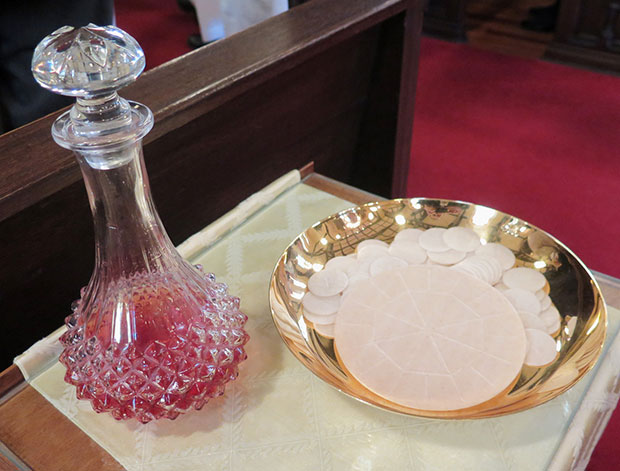
Wine and unconsecrated hosts wait to be brought forward during a Mass.
By Fr. Thom Hennen
Question Box
Q: What happened to offering Holy Communion under both forms? It seems like most of the churches I go to only offer the host and rarely the chalice?

A: In terms of Church teaching, the ideal is that Holy Communion is offered under both forms — or “species” — both the body and blood of Christ. In many parishes, this is still the case, at least on Sundays, but after the pandemic the practice was slow to return.
Why is offering Holy Communion under both species the ideal? First, we can point to Scripture. All of the accounts of the “Last Supper” or first Eucharist make it clear that Jesus took and blessed both bread and wine, saying, “This is my body that is for you … This cup is the new covenant in my blood” (1 Corinthians 11:24-25).
Also, the “General Instruction of the Roman Missal” states: “Holy Communion has a fuller form as a sign when it takes place under both kinds. For in this form the sign of the Eucharistic banquet is more clearly evident and clearer expression is given to the divine will by which the new and eternal Covenant is ratified in the Blood of the Lord, as also the connection between the Eucharistic banquet and the eschatological banquet in the Kingdom of the Father.”
An addendum to the “General Instruction” from the U.S. bishops further notes: “From the first days of the Church’s celebration of the Eucharist, Holy Communion consisted of the reception of both species in fulfillment of the Lord’s command to ‘take and eat … take and drink.’ The distribution of Holy Communion to the faithful under both kinds was thus the norm for more than a millennium in Catholic liturgical practice.”
So, why is this not done everywhere? There could be a couple of reasons. As I mentioned, the pandemic really did a number on this, as parishes discontinued distribution of the Precious Blood. Even before that, in some places, especially in more rural parishes, it may have been difficult to have in place the necessary extraordinary ministers of Holy Communion. Sadly, I am afraid that in many places it hinges on the individual decision of the priest. This may be out of an abundance of caution in care for the Blessed Sacrament or not wanting to spread germs or simply because it is easier. There may be times when it is better not to offer the chalice, but it should be the exception rather than the rule.
Having said that, I will admit that we do not typically have Communion under both species at our weekday liturgies at Sacred Heart Cathedral in Davenport. This has in part to do with the smaller space of the chapel and the fact that I never quite know who will be there and if I will have a deacon or extraordinary minister of Holy Communion to assist me. This may be something I need to reexamine.
I want to be clear, while the Church has a clear history and preference of Communion under both forms, it is not as though you receive less Jesus if you only receive under one or the other form. In the smallest morsel or the tiniest sip, we receive the whole Christ, body, blood, soul and divinity.
(Father Thom Hennen serves as the pastor of Sacred Heart Cathedral in Davenport. Send questions to messenger@davenportdiocese.org)










